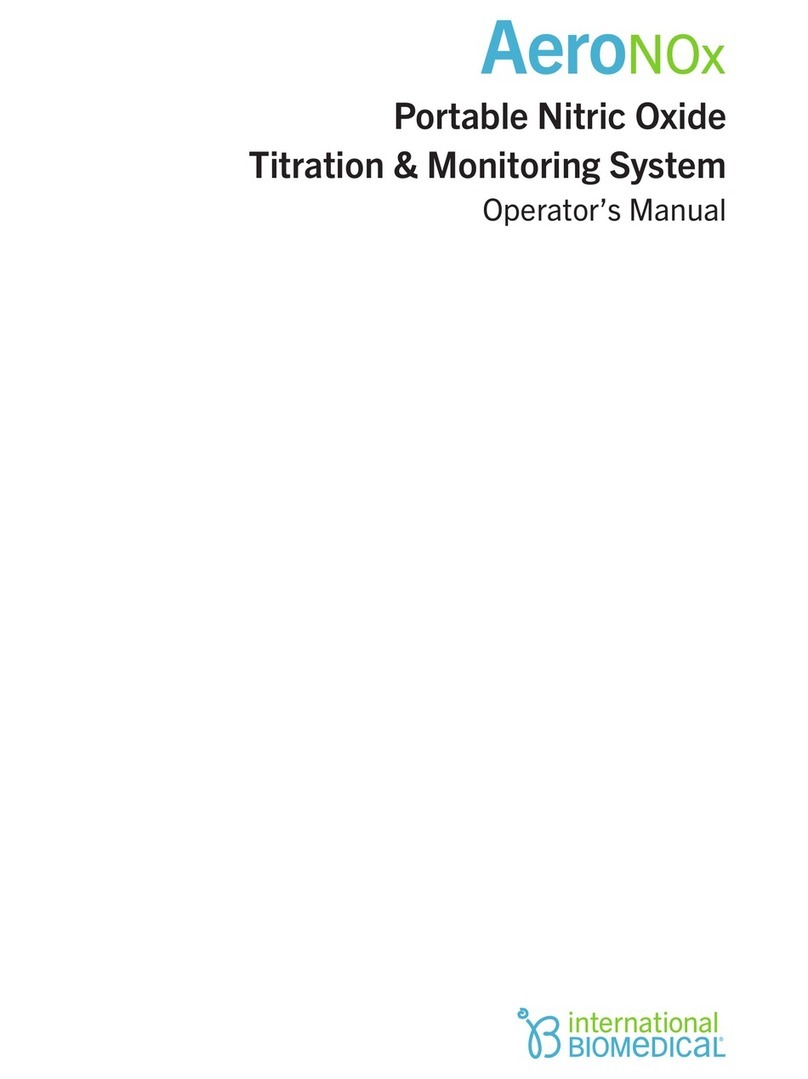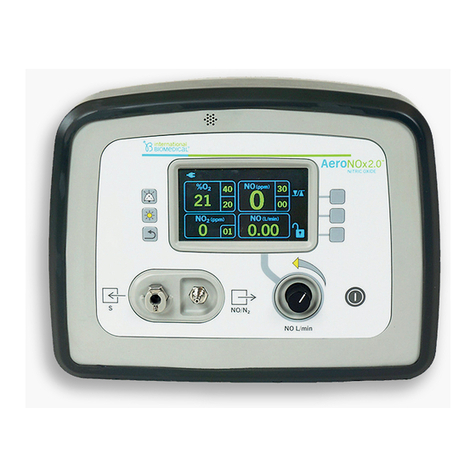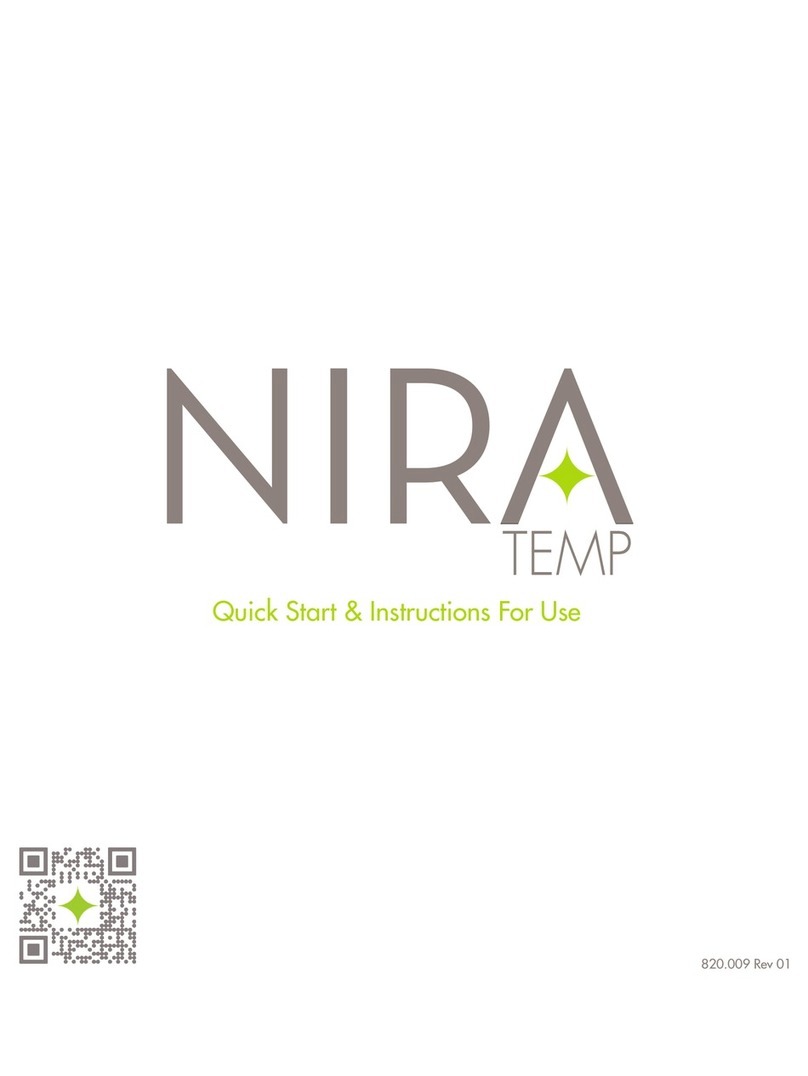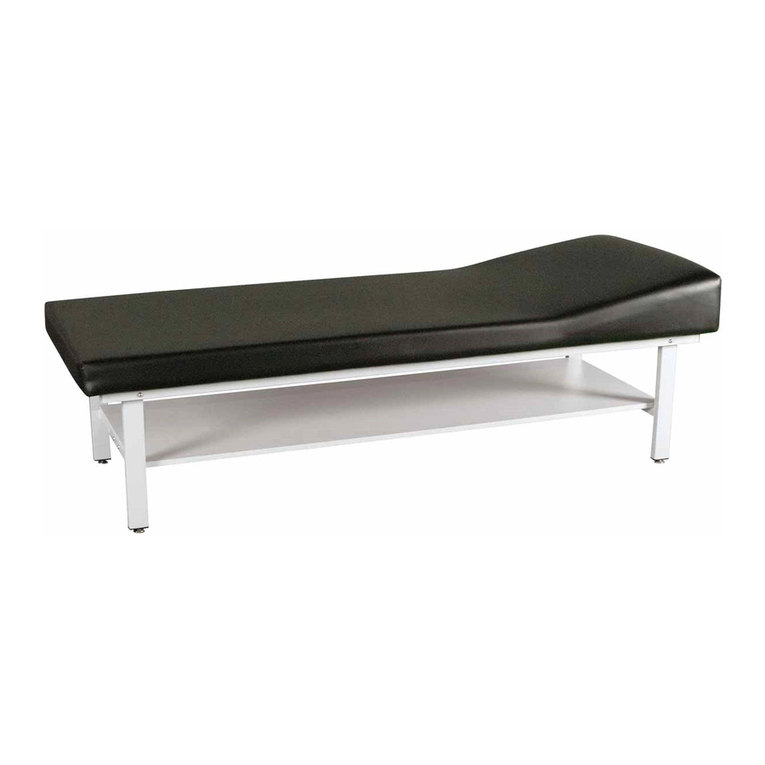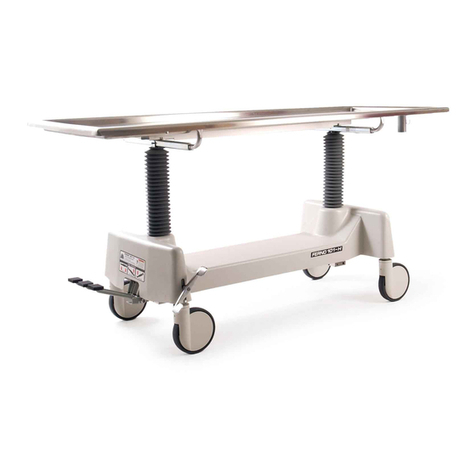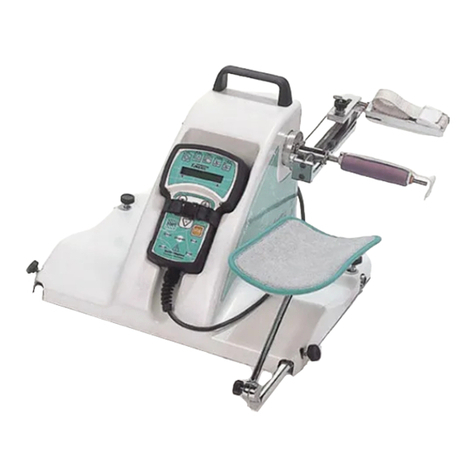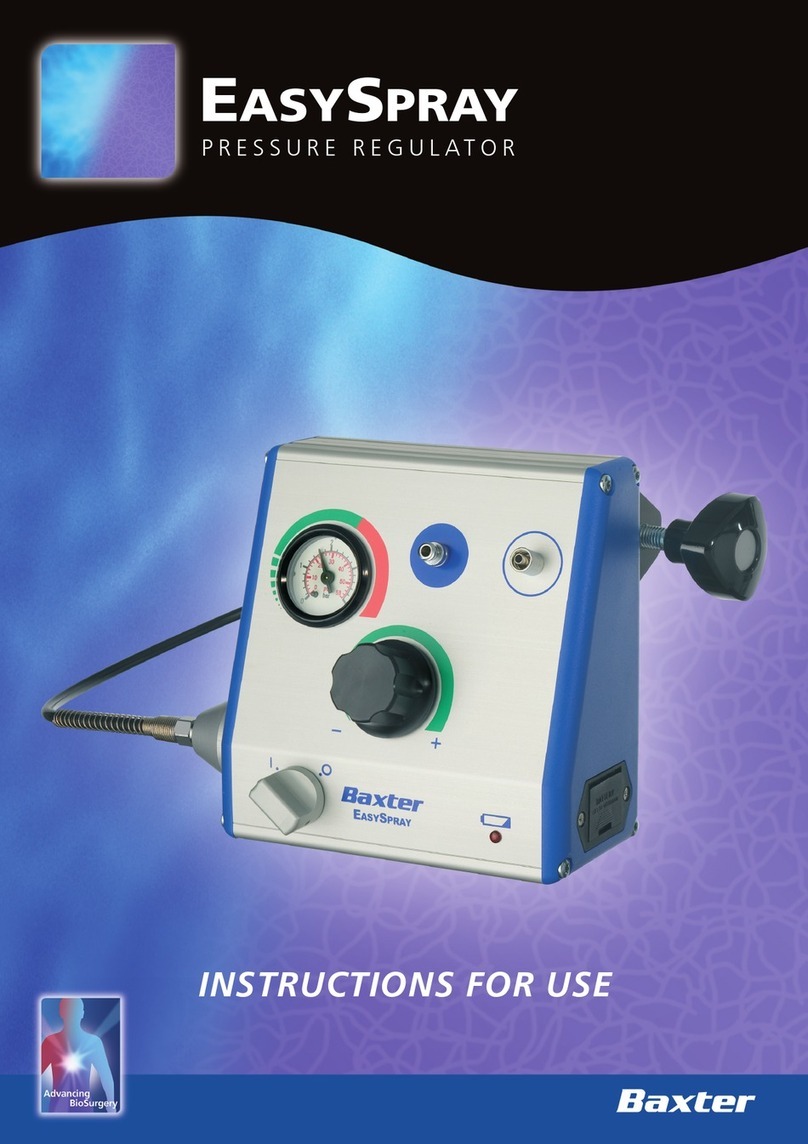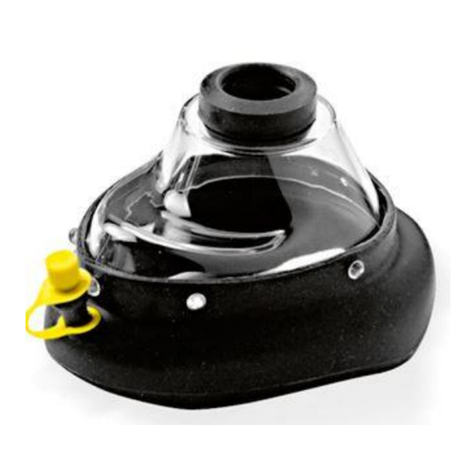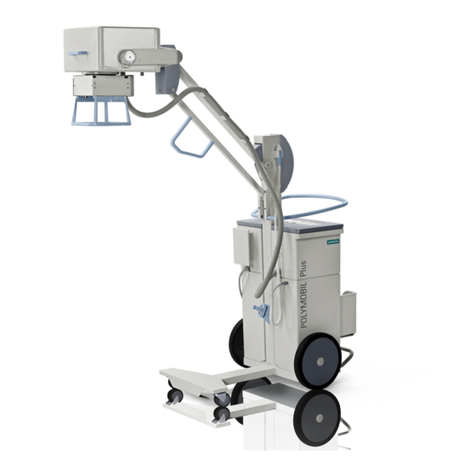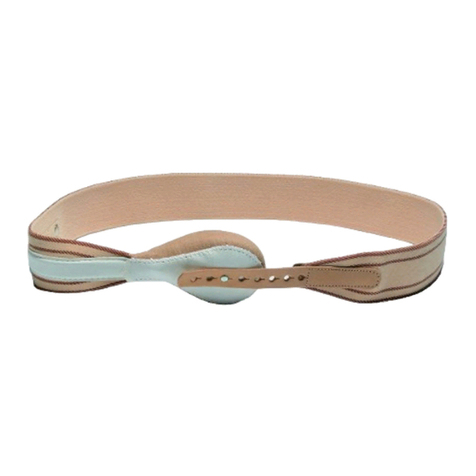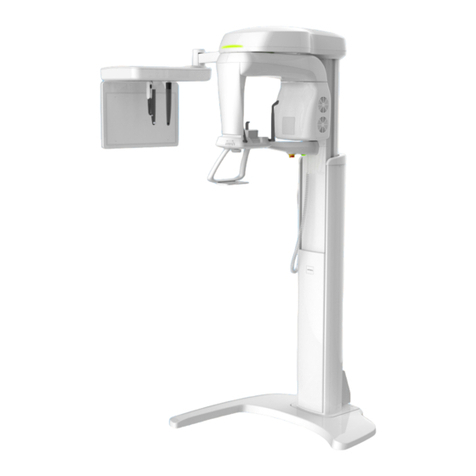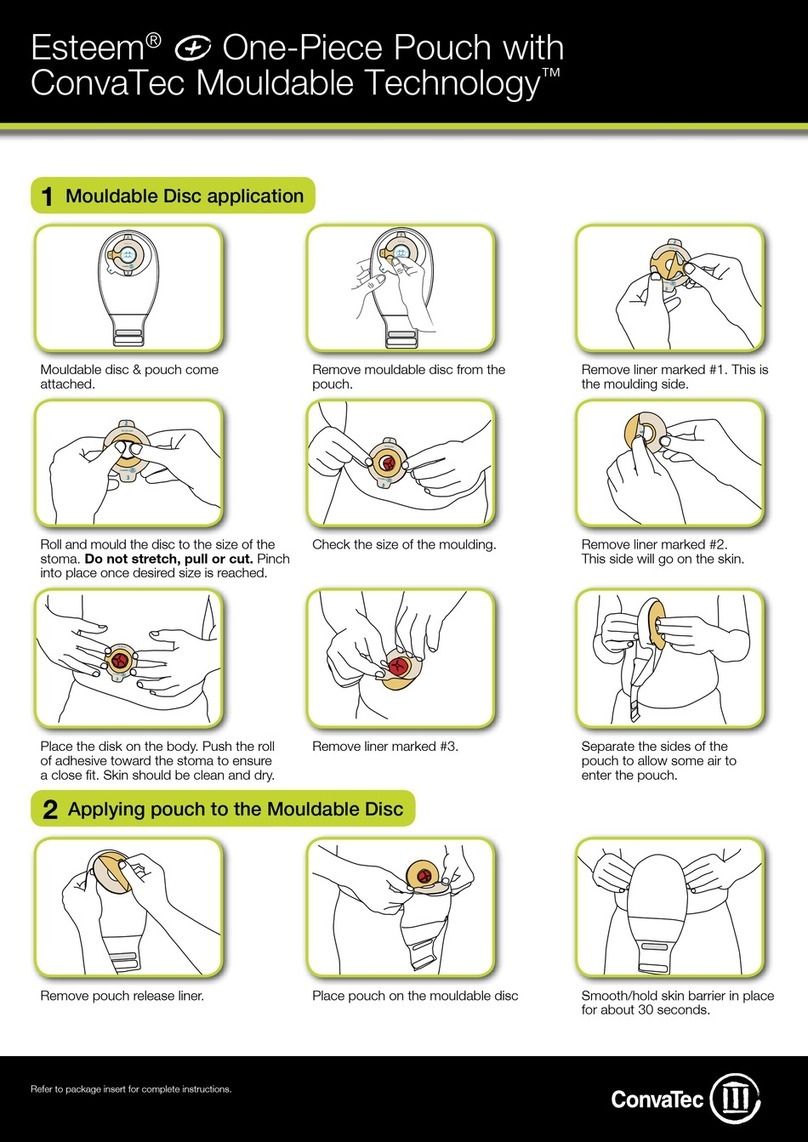International Biomedical AirBORNE User manual

Observation & Phototherapy Light System
Technical Manual
®

P
h
F
a
E-
M
We
M
a
In
t
8
2
A
u
U
S
A
u
E
m
P
r
2
5
T
h
Ob
s
h
one:
(
5
1
a
x: (512)
M
ail: sa
l
e
bsite:
h
a
iling ad
d
t
ernation
2
06 Cros
s
u
stin, TX
S
A
u
thorize
d
m
ergo E
u
r
insesse
g
5
14 AP
h
e Hague
,
s
erv
a
T
e
1
2) 873-0
0
873-909
0
l
es@int-
b
h
ttp://ww
w
d
ress:
al Biom
e
s
Park D
r.
78754
d
represe
n
u
rope
g
racht 20
,
The Ne
t
a
tio
n
Lig
h
e
chn
0
33
0
b
io.com
w
.int-bio
.
e
dica
l
r.
n
tative i
n
t
herland
s
n
&
P
h
t S
ys
ica
l
M
.
com
n
Europe
s
P
hot
o
ys
te
m
M
an
u
for Reg
u
o
the
r
m
u
a
l
u
latory A
f
r
ap
y
f
fairs:

TABLE OF CONTENTS
Part No. 715-0002, Rev. D - 1 -
SECTION 1: GENERAL INFORMATION ............................................................................................ 2
INTENDED USE ......................................................................................................................... 2
PHYSICAL CHARACTERISTICS .............................................................................................. 2
Light Bar ......................................................................................................................... 2
Control Box .................................................................................................................... 3
AC Power Supply (Optional) ......................................................................................... 3
CLASSIFICATION ..................................................................................................................... 3
SECTION 2: SAFETY INFORMATION ................................................................................................ 4
EXPLANATION OF TERMINOLOGY ........................................................................................ 4
GENERAL SAFETY INFORMATION ......................................................................................... 4
SYMBOLS .................................................................................................................................. 9
SECTION 3: SET-UP INSTRUCTIONS ............................................................................................. 10
UNPACKING AND ASSEMBLY .............................................................................................. 10
SECTION 4: OPERATING INSTRUCTIONS ..................................................................................... 11
CONTROL BOX FEATURES ................................................................................................... 11
LIGHT BAR FEATURES .......................................................................................................... 12
SECTION 5: PREVENTATIVE MAINTENANCE ............................................................................... 14
DAILY MAINTENANCE ........................................................................................................... 14
OPERATIONAL CHECK ............................................................................................... 14
CLEANING THE LIGHT BAR ....................................................................................... 14
MONTHLY MAINTENANCE .................................................................................................... 15
PRODUCT RECYCLING .......................................................................................................... 15
SECTION 6: TROUBLESHOOTING AND REPLACEMENTS........................................................... 16
REMOVAL/REPLACEMENT OF CONTROL BOX .................................................................. 17
SECTION 7: CIRCUIT DESCRIPTION .............................................................................................. 1 8
CONTROL BOX ....................................................................................................................... 18
LED BOARD ............................................................................................................................ 18
PHOTOTHERAPY AND OBSERVATION LEDS .......................................................... 18
PHOTOTHERAPY LIFETIME WARNING LED ............................................................. 18
SECTION 8: SPECIFICATIONS ........................................................................................................ 19
GENERAL MECHANICAL SPECIFICATIONS ........................................................................ 19
ELECTRICAL SPECIFICATIONS ............................................................................................ 19
OPERATIONAL SPECIFICATIONS ........................................................................................ 19
OPERATING, STORAGE, AND TRANSPORT ENVIRONMENT ............................................ 21
EMC COMPLIANCE ................................................................................................................ 21
SECTION 9: WARRANTY ................................................................................................................. 24
SECTION 10: SYSTEM DOCUMENTATION ..................................................................................... 25
EUROPEAN REGULATORY AFFAIRS REPRESENTATIVE ................................................. 25
PARTS AND ACCESSORIES .................................................................................................. 25

Part No. 715-0002, Rev. D - 2 -
SECTION 1: GENERAL INFORMATION
INTENDED USE
The Airborne Observation and Phototherapy Light System is intended to be used in one of two
modes: observation light mode or phototherapy light mode. The observation light mode utilizes white
light and is intended to be used as auxiliary lighting that supplements the ambient lighting. The
phototherapy light mode utilizes blue light and is intended to be used in the treatment of neonatal
hyperbilirubinemia.
NOTE: Before using the Observation & Phototherapy Light System, read all sections of
this manual carefully. There are safety considerations that should be read and
understood before use.
PHYSICAL CHARACTERISTICS
The Observation and Phototherapy Light System consists of two main sections: the light emitting diode
(LED) light bar and the control box.
Light Bar
The light bar is contained within a lightweight anodized aluminum enclosure with two
compression mounting feet. The light bar should always be positioned between the inner and
outer incubator chambers. The intensity of the light will change with distance from the patient.
The light bar has a thin LED diffuser that protects the board from incidental debris or fluid
exposure. The white LEDs emit a light in the range of 360 - 830 nm. The blue LEDs emit light
in the range of 400 - 500 nm (dominant wavelength range 450 - 465 nm). This range
corresponds to the spectral absorption of light by bilirubin, and is thus considered to be the
most effective for the degradation of bilirubin. Blue LEDs do not emit significant energy in the
ultraviolet (UV) region of the spectrum, so there is no concern about UV exposure to the infant.
In addition, blue LEDs do not emit significant energy in the infrared (IR) region of the spectrum,
so there is no concern about IR exposure and excessive warming of the infant. As with all
phototherapy lights, the operator must ensure protective eyeshades are placed on the infant’s
eyes to protect them from exposure to the light.
LEDs have minimal light output degradation over their lifetime with proper use. The
phototherapy LEDs have a life span of approximately 39,000 hours. The light bar has a red
warning light that will illuminate and indicate the LEDs have reached end of life. At that point
the light bar should be replaced. The LEDs should also be checked in accordance with the
preventative maintenance schedule.

SECTION 1: GENERAL INFORMATION
Part No. 715-0002, Rev. D - 3 -
Control Box
The control box plugs into the incubator’s lamp connector and mounts to the incubator via two
screws. Alternatively the control box can receive power form the optional AC power supply. It
has a three position switch: O - OFF (center position), I - Observation Light ON, and II -
Phototherapy Light ON. When the phototherapy light is ON, a yellow caution light on the control
box is turned on alerting the user that the phototherapy lamp is on.
AC Power Supply (Optional)
There is an optional medically certified AC power supply that can supply power to the control
box. The AC power supply be powered with 80 ~ 264 VAC, 47 ~ 63 Hz and outputs 9 VDC.
The only power supply approved for use with the Observation & Phototherapy Light System is
Mean Well Enterprises GSM40B09-P1J AC-DC Medical Adapter.
CLASSIFICATION
According to the standard EN60601-1 of the International Electrotechnical Commission, Medical
electrical equipment, Part 1: General requirements for safety, the Observation & Phototherapy Light
System is classified as follows:
Class II / Externally Powered, according to the type of protection against electric shock
Ordinary, according to the degree of protection against harmful ingress of water

Part No. 715-0002, Rev. D - 4 -
SECTION 2: SAFETY INFORMATION
The Observation & Phototherapy Light System is designed to be used only by appropriately trained
personnel and under the direction of qualified medical personnel operated in a manner consistent with
the instructions contained in this manual and according to hospital guidelines. All personnel operating
the lighting system must be familiar with the warnings and operating procedures contained in this
manual as well as currently known risks and benefits of infant phototherapy equipment use. In
addition, please refer to your institution’s policy and procedure for administering phototherapy.
International Biomedical is not to be held responsible if the Observation & Phototherapy Light System
is used in a manner inconsistent with the instructions herein. This device has no performance which is
considered essential.
EXPLANATION OF TERMINOLOGY
This manual presents three types of precautionary information. The three types of statements are of
equal importance to the safe and effective use of the light system. Each statement is categorized by
using an introductory word in bold face as follows:
WARNING: Maintenance or operating procedure, technique, etc., which may result
in personal injury or loss of life if not carefully followed.
CAUTION: Maintenance or operating procedure, technique, etc., which may result in
patient harm or damage to equipment if not carefully followed.
NOTE: Maintenance or operating procedure, technique, etc., which is considered
essential to emphasize.
GENERAL SAFETY INFORMATION
The principal WARNING and CAUTION notices to be observed in use of the Observation &
Phototherapy Light System are brought together here for emphasis.
WARNINGS
OBSERVE BEST PRACTICE: The instructions in this manual in no way supersede established
medical procedures or staff preference concerning patient care.
INCORRECT USE: Incorrect use of the light or the use of parts and accessories that are not
manufactured or supplied by International Biomedical can damage the light and may cause
injury to the patient and/or user.
DAMAGED OR MISSING PARTS: If any part of the system is damaged in any way or missing,
discontinue use immediately.

SECTION 2: SAFETY INFORMATION
Part No. 715-0002, Rev. D - 5 -
PLACEMENT OF LIGHT BAR: Placement should be centered between the top of the inner and
outer chambers where the patient cannot access unit. Do not place the light bar inside the
inner chamber.
EYE PROTECTION: Do not look directly into the LEDs. During observation or phototherapy
light usage, always protect the patient’s eyes with eye shields or equivalent. Per your
institution’s protocol, periodically verify that the baby’s eyes are protected and free of infection.
Patients adjacent to the light may also need to be protected with eye shields or equivalent.
EXPLOSION HAZARD: Do not use the Observation & Phototherapy Light System in the
presence of flammable anesthetics or other flammable gases.
USE OF OXYGEN INCREASES FIRE DANGER: Equipment is not suitable for use in the
presence of a flammable anesthetic mixture with air or with oxygen or nitric oxide.
AMBIENT CONDITIONS: Varying ambient conditions, such as the ambient temperature and/or
different radiation sources, may adversely affect the patient. Please refer to your institution’s
policy and procedure regarding appropriate ambient conditions.
OPERATOR SAFETY: Sensitive individuals may experience headache, nausea, or mild vertigo
if he/she stays too long in the irradiated area. Using the phototherapy system in a well-lit area
or wearing glasses with yellow lenses can reduce side effects.
PHOTOISOMERS: Bilirubin Photoisomers may cause toxic effects.
PHOTOSENSITIVE DRUGS: The phototherapy light generated can degrade photosensitive
medications. Do not place or store any drugs or infusion liquids near or in the radiation area.
SUNLIGHT AND RADIANT HEAT: Avoid direct sunlight or radiant heat which can cause a
dangerous increase in the chamber’s air temperature and affect the amount of irradiation being
provided to the patient.
HOT SURFACE: Turn off the light bar and allow the light bar to cool before handling as the
light bar can be hot.
SHOCK HAZARD: Do not touch the lighting system and touch the patient simultaneously.
TEMPERATURE MONITORING: The use of the baby or skin temperature probes is
recommended to track the infant’s temperature during phototherapy. In addition, use of
reflective foils may cause hazardous body temperatures. Monitor the infant’s skin temperature
per your institution’s policy during phototherapy to avoid fluctuation in body temperature.

SECTION 2: SAFETY INFORMATION
Part No. 715-0002, Rev. D - 6 -
WATER BALANCE: The use of the phototherapy light can disturb the water balance of some
patients.
HEAT SUPPLY: The phototherapy light may impact the heat supply in the incubator and the
patient’s body temperature.
ELECTRICAL POWER: Always switch off the power and disconnect the power cord when
cleaning the light.
The blue phototherapy light can hinder clinical observation by making skin color changes, such
as cyanosis.
Do not modify this equipment without authorization of the manufacturer.
When using the Phototherapy Light, the patient’s bilirubin values shall be checked regularly.
Use of this equipment adjacent to or stacked with other equipment should be avoided because
it could result in improper operation. If such use is necessary, this equipment and the other
equipment should be observed to verify that they are operating normally.
Use only AirBorne cables and accessories. Cables and accessories other than those supplied
by AirBorne may result in unacceptable operation of the AirBorne Observation &
Phototherapy Light System and will void AirBorne equipment warranty.
Portable RF communications equipment (including peripherals such as antenna cables and
external antennas) should be used no closer than 30 cm (12 inches) to any part of the
Observation & Phototherapy Light System, including cables specified by the manufacturer.
Otherwise, degradation of the performance of this equipment could result.
Prior to administering phototherapy, ensure phototherapy has been prescribed for infant.
Do not use the Observation & Phototherapy Light System during magnetic resonance imaging
(MRI) scanning. The Observation & Phototherapy Light System may affect the MRI image and
the MRI unit may affect the Observation & Phototherapy Light System output.
Intensive phototherapy may not be appropriate for all infants (i.e. preterm infants 1000 g).

SECTION 2: SAFETY INFORMATION
Part No. 715-0002, Rev. D - 7 -
Refer to the jaundice management guidelines or regulations in your country to determine the
best treatment path for neonatal hyperbilirubinemia; such as the AAP Guidelines (American
Academy of Pediatrics Clinical Practice Guideline - Management of Hyperbilirubinemia in the
Newborn Infant 35 or More Weeks of Gestation); or NICE guidelines (National Institute for
Health and Clinical Excellence - Neonatal Jaundice).
CAUTIONS
The lighting system should be turned off when not in use.
Route the light power cord carefully to keep out of patient’s reach. Route the power cord to the
rear right corner of the chamber, down to the bottom of the chamber, then forward so that the
cord will pass through the lower ventilation recess on the outer chamber. Avoid setting the
outer chamber on the cord.
Federal Law (U.S.) restricts this device to sale or use by or on the order of a physician (or
properly licensed practitioner).
The light bar’s electronics contain static sensitive components that can be damaged by
improper handling. Use approved grounding techniques for work areas and service personnel.
Do not autoclave, pressure sterilize, or gas sterilize any portion of the lighting system. Use
cleaning solutions sparingly as excessive solution can flow into the light, control box, or cable
and cause damage to internal components. Do not spray, soak, or immerse the lighting system
in any liquid. Do not use petroleum-based, alcohol, acetone, or other harsh solvents.
Do not position the end use product, Observation & Phototherapy Light System, or optional
power supply to make it difficult to operate the disconnection device.
The end use product must include a means of isolating the Observation & Phototherapy Light
System from supply mains when not used with the optional medically certified power supply.
Clear objects from the area in the pathway of the light emitted from the Observation &
Phototherapy Light System.
NOTES
Only mount the light bar in between the chambers. The distance between the light bar and the
effective surface area should be 8.8 inches. If the distance between the light bar and the infant
is increased the irradiance intensity will decrease. If the distance between the light bar and the
infant is decreased the irradiance intensity will increase.

SECTION 2: SAFETY INFORMATION
Part No. 715-0002, Rev. D - 8 -
Check Irradiance intensity monthly with a calibrated meter to ensure the light is outputting
correctly, such as the LifeBorne
Light Meter (PN 736-0001).
Before installing the Observation & Phototherapy Light System and administering phototherapy,
read all sections of this manual carefully. There are safety considerations that should be read
and understood before use.
The unit uses a specific type of LED. Consult International Biomedical for repair and
replacement of LEDs. Use of incorrect LEDs can adversely affect performance and/or damage
the light.
If using pulse oximetry during phototherapy, keep the sensor out of the irradiation field. If the
sensor is exposed to irradiation, the reading might be inaccurate or the unit might read zero for
the duration of the active irradiation period.

S
Pa
r
S
Y
T
h
la
b
C
o
ECTIO
N
r
t No. 715-00
0
Y
MBO
L
h
e followin
g
b
els. Thes
e
o
mmission,
N
2: S
A
0
2, Rev. D
L
S
g
symbols
a
e
internati
o
IEC 6087
8
I
I
I
O
(Yel
backg
r
(Yel
backg
r
(Blue bac
(Blue bac
A
FETY
a
ppear in t
h
o
nally reco
g
8
and IEC
6
Ob
s
I
Ph
o
O
OF
F
l
ow
r
ound)
A
tt
e
l
ow
r
ound)
Wa
r
kground)
A
lw
kground)
Foll
INFO
R
h
e Observa
t
g
nized sym
b
6
0417.
s
ervation Lig
h
o
totherapy Li
g
F
e
ntion, consul
r
ning! Hot S
u
ays protect t
h
ow Operator’
R
MATI
O
- 9 -
t
ion & Pho
t
b
ols are d
e
h
t Power On
(
g
ht Power On
t accompany
u
rface
h
e baby’s ey
e
s Instruction
s
O
N
t
otherapy L
e
fined by th
e
(
when incuba
n
(when incub
y
ing documen
e
s with eye p
a
s
L
ight Syste
m
e
Internati
o
a
tor is ON)
b
ator is ON)
ts
a
tches or eq
u
m
docume
n
o
nal Electr
o
u
ivalen
t
n
tation and
o
technical

Pa
r
S
U
T
h
c
o
1.
2.
3.
4.
5.
6.
r
t No. 715-00
0
ECTIO
N
NPAC
K
h
e Observa
o
ntrol box.
Locat
e
the in
c
box.
A
to the
cable
i
Caref
u
incub
a
A
ttac
h
nuts, i
f
Scre
w
NOT
E
Moun
t
cham
b
Caref
u
the rig
is a h
e
cham
b
cable
d
0
2, Rev. D
N
3: S
E
K
ING A
tion & Pho
t
Upon arriv
a
e
the lamp
c
c
ubator ch
a
A
lternativel
y
connector
e
i
nto an
A
C
u
lly push th
a
tor.
h
the contr
o
f
required f
o
w
the power
E
:Th
e
t
the light b
e
b
er layers
a
u
lly route t
h
ht hand si
d
e
ad door o
n
b
er and the
d
oes not in
E
T-UP
I
ND AS
S
t
otherapy
L
a
l, inspect
a
c
onnector
o
a
ssis) and
c
y
, if using t
h
e
xtending
f
power sou
e wires int
o
Figur
e
l box to th
e
o
r incubat
o
cable con
n
e
connecto
r
e
tween the
a
nd securin
h
e cable su
c
d
e and out
t
n
the right
s
n out the b
o
terfere wit
h
I
NSTR
U
S
EMB
L
L
ight Syste
m
a
ll parts fo
r
o
n the bac
k
c
onnect to
t
h
e optional
f
rom the b
o
r
ce.
o
the incub
a
e
1 Inc
u
e
incubator
o
r model) p
r
n
ector into
t
r
is keyed t
o
inner and
o
g the oute
r
c
h that, wh
e
t
he bottom
s
ide of the
c
o
ttom slot
b
h
the functi
o
- 10 -
U
CTIO
N
LY
m
consists
o
r
any dama
g
k
, right han
d
t
he connec
t
AC power
o
ttom of the
a
tor chassi
s
u
bator Lig
using two
#
r
ovided.
t
he control
o
facilitate
p
o
ute
r
cha
m
r
chamber
w
e
n the out
e
slot betwe
e
c
hamber, r
o
b
etween th
e
o
n of the d
o
N
S
of the light
g
e.
d
corner of
t
or extendi
n
supply, co
e
control bo
x
s
to allow t
h
ht Bar Co
n
#
6 pan-he
a
box.
p
roper ins
u
m
be
r
by co
m
w
ith the lat
c
e
r chamber
e
n the gas
k
o
ute the ca
e
gasket a
n
o
or.
bar with c
a
the incub
a
n
g from th
e
nnect the
p
x
and plug
h
e control
b
n
nector
a
d Phillips
m
u
lation.
m
pressing t
c
h pins.
is mounte
d
k
et and the
ble toward
s
n
d the out
e
a
ble attach
e
a
tor (this m
a
e
bottom of
p
ower supp
the power
b
ox to sit fl
u
m
achine sc
he light be
t
d
, the cabl
e
outer cha
m
s
the back
o
e
r chamber
e
d and the
a
y be insid
e
the control
ly connect
o
supply inp
u
u
sh on the
rews (and
t
ween the t
w
e
runs dow
n
m
ber. If th
e
o
f the
ensuring t
h
e
o
r
u
t
w
o
n
e
re
h
e

Pa
r
S
T
h
O
p
c
o
W
A
C
T
h
1.
2.
3.
4.
1:
C
o
to
W
A
2:
T
h
P
h
r
t No. 715-00
0
ECTIO
N
h
is section
c
p
eration in
o
nserve po
w
A
RNING:
C
ONTR
O
h
e lighting
s
Light
B
Photo
t
Eye S
h
Selec
t
Light Bar
o
nnect the
p
ensure pr
o
A
RNING:
Photothe
r
h
e Phototh
e
h
ototherap
y
0
2, Rev. D
N
4: O
c
ontains o
p
both mode
s
w
er.
Avoi
d
cha
m
O
L BO
X
s
ystem con
B
ar Power
C
t
herapy O
N
h
ields Req
u
t
or Switch
Power Co
r
p
ower cor
d
o
per orient
a
OBS
E
sup
e
pati
e
r
apy ON
W
e
rapy ON
W
y
is turned
O
2
P
ERA
T
p
erating pr
o
s
and indic
a
d
direct s
u
m
ber air te
m
X
FEAT
t
rols are lo
c
C
ord Conn
e
N
Warning I
u
ired Warn
r
d Conne
c
d
from the li
a
tion. Twis
t
E
RVE BE
S
e
rsede est
a
e
nt care.
W
arning In
d
W
arning In
d
O
N.
1
T
ING IN
o
cedures f
o
a
tors are d
e
u
nlight or
r
m
perature
.
URES
c
ated on th
Figure
e
cto
r
ndicato
r
ing
c
tor
ght bar to t
t
clockwise
S
T PRACTI
a
blished
m
d
icator
d
icator con
s
3
- 11 -
STRU
C
o
r the Obse
e
tailed. T
h
r
adiant he
a
.
e control b
o
2 Con
t
he control
b
until the c
o
CE. The i
n
m
edical pr
o
s
ists of a y
e
4
C
TION
S
e
rvation &
P
h
e light sho
a
t which c
a
ox in the b
a
trol Box
b
ox power
o
nnector is
n
struction
s
o
cedures
o
e
llow LED t
S
P
hotothera
p
uld be off
w
a
n cause
a
a
ck right o
f
connector.
completel
y
s in this
m
o
r staff pre
f
hat illumin
a
p
y Light Sy
s
w
hen not in
a
dangero
u
f
the incub
a
The conn
e
y
secured.
m
anual in
n
f
erence c
o
a
tes when
t
s
tem.
use to
u
s increas
e
a
tor.
e
ctor is ke
y
n
o way
o
ncerning
t
he
e
in
y
ed

S
Pa
r
3:
W
lig
4:
W
a
n
p
h
W
A
N
O
L
T
h
W
A
ECTIO
N
r
t No. 715-00
0
Eye Shiel
d
hen the lig
h
hting effec
t
Selector
S
hen the po
w
n
d select b
e
h
ototherap
y
A
RNING:
O
TE:
IGHT
B
h
e light bar
A
RNING:
N
4: O
P
0
2, Rev. D
d
s Requir
e
h
t is in use,
t
and the ir
r
S
witch
w
er to the i
e
tween the
y
light turns
EYE
phot
o
or e
q
bab
y
may
If usi
n
field.
unit
m
B
AR FE
A
has sever
a
HOT
han
d
P
ERA
T
e
d Warnin
g
eye shiel
d
r
adiation b
e
ncubator i
s
two mode
s
ON. The
c
PROTECT
o
therapy l
i
q
uivalent.
y
’s eyes ar
e
also need
n
g pulse o
x
If the sen
s
m
ight read
z
A
TUR
E
a
l indicator
s
SURFAC
E
d
ling.
T
ING IN
g
s or equiv
a
e
ing provid
e
s
ON, the s
e
s
. In positi
o
c
enter posi
t
ION. Do n
i
ght usag
e
Per your i
n
e
protecte
d
to be prot
e
x
imetry dur
i
s
or is expo
s
z
ero for th
e
E
S
s
which sh
o
E
. Turn of
f
STRU
C
- 12 -
a
lent shoul
d
e
d by phot
o
e
lector swi
t
o
n I, the ob
s
t
ion, O, is t
h
ot look di
r
e
, always
p
n
stitution’
s
d
and free
e
cted with
i
ng phototh
s
ed to irra
d
e
duration
o
o
uld be obs
f
the light
b
C
TION
S
d
be used t
o
o
therapy.
t
ch can be
s
ervation li
g
h
e OFF po
s
r
ectly into
p
rotect the
s
protocol
of infecti
o
h
eye shiel
d
h
erapy, kee
p
d
iation, the
r
o
f the activ
e
erved.
b
ar and all
o
S
o
protect t
h
used to tur
g
ht turns
O
s
ition.
the LEDs.
patient’s
e
, periodic
a
o
n. Patien
t
d
s or equi
v
p
the sens
o
r
eading mi
g
e
irradiatio
n
o
w the lig
h
h
e patient f
r
n ON the li
g
O
N. In posi
t
During o
b
e
yes with
e
a
lly verify
t
t
s adjacen
v
alent.
o
r out of th
e
g
ht be inac
c
n
period.
h
t bar to c
o
r
om the sp
o
g
ht system
t
ion II, the
b
servatio
n
e
ye shield
s
t
hat the
t to the lig
e
irradiatio
n
curate or t
h
o
ol before
o
t
or
s
ht
n
h
e

SECTION 4: OPERATING INSTRUCTIONS
Part No. 715-0002, Rev. D - 13 -
1: Phototherapy Light Lifetime Indicator
When the red phototherapy lifetime indicator on the light bar is illuminated, the blue LEDs have
exceeded their 39,000 hour limit and it is time to replace the light bar.
2: Phototherapy LEDs
NOTE: Check irradiance intensity monthly with a calibrated light meter to ensure that the
light is outputting correctly.
NOTE: The unit uses a specific type of LED. The use of incorrect LEDs can adversely
affect performance and/or damage the light.
Nine blue LEDs are used for the Phototherapy. If one or more of these LEDs goes out, the intensity
should immediately be checked and the light bar should be replaced.
3: Observation LEDs
NOTE: The unit uses a specific type of LED. The use of incorrect LEDs can adversely
affect performance and/or damage the light.
Six white LEDs are used for the Observation Light. If one or more of these LEDs goes out, the light
intensity should be checked and the light bar should be replaced if the lighting is determined not to be
sufficient for use.

Part No. 715-0002, Rev. D - 14 -
SECTION 5: PREVENTATIVE MAINTENANCE
To ensure proper operation, standby readiness, malfunction reporting, and performance of required
maintenance, International Biomedical recommends following a preventative maintenance program.
The daily preventative maintenance can be performed and recorded by knowledgeable incubator
transport personnel. Monthly maintenance should be performed and recorded by a qualified
biomedical technician. No other preventative maintenance is required.
DAILY MAINTENANCE
The following maintenance procedures should be performed on a daily basis by a knowledgeable
incubator transport person.
OPERATIONAL CHECK
1. Turn the Incubator ON and then turn ON the observation light. By looking at a reflection
of the LEDs, verify that all six white LEDs are illuminated. If they are not, check that the
intensity level is high enough to adequately view the patient.
2. Turn ON the Phototherapy. By looking at a reflection of the LEDs, verify that all nine
blue LEDs are illuminated. If they are not, have the light bar checked by a qualified
biomedical technician.
3. Inspect the power cable for wear or damage and replace if necessary. Verify that the
cable is routed appropriately and not pinched at any point.
CLEANING THE LIGHT BAR
CAUTION: CLEANING AND CARE: Do not autoclave, pressure sterilize, or gas sterilize
any portion of the lighting system. Use cleaning solutions sparingly as
excessive solution can flow into the light, control box, or cable and cause
damage to internal components. Do not spray, soak, or immerse lighting
system in any liquid. Do not use petroleum-based, alcohol, acetone, or other
harsh solvents.
Clean the light bar and control box with mild soap or detergent and water solution.
Household ammonia diluted in water in the concentrations recommended for hospital cleaning
may also be used. These solutions may be applied with a soft absorbent cloth, followed by
rinsing with clean water. Wipe away residue with soft chamois or cellulose sponge material.

SECTION 5: PREVENTATIVE MAINTENANCE
Part No. 715-0002, Rev. D - 15 -
MONTHLY MAINTENANCE
Turn on the Phototherapy and using the LightBorne® Light Meter (PN 736-0001) measure the
irradiance intensity in the center of the incubator. Verify that it is 11 W/cm2/nm or greater. If using
the optional power supply, the irradiance intensity should measure 20 W/cm2/nm or greater. If it is
not, take the unit out of service and replace the light bar.
PRODUCT RECYCLING
The lighting system should be returned to International Biomedical for recycling when it reaches the
end of its life (8 years).

Part No. 715-0002, Rev. D - 16 -
SECTION 6: TROUBLESHOOTING AND REPLACEMENTS
Problem Possible Solutions
Neither set of LEDs comes on, and in
Phototherapy mode the yellow warning LED
does not illuminate.
Turn the incubator ON.
Plug in the control box.
Ensure the power switch is in the “I”
or the “II” position.
If using the optional AC power
supply, ensure that it is plugged
into an AC power source
If problem persists, the wiring to the
control box has been damaged;
service needed.
Neither set of LEDs comes ON, although in
Phototherapy mode the yellow warning LED is
illuminated.
Ensure the power cable is plugged
in at both ends.
If problem persists, the power cable
or the LED board has been
damaged; service needed.
The irradiation intensity of blue LEDs are
working to specification but the red end of life
LED is ON.
The blue LEDs are working beyond
specification; the unit may be used
but the light intensity must be
checked frequently to ensure the
patient is getting prescribed
treatment.
The irradiation intensity of blue LEDs is not up
to specification, but the end of life LED is not
ON.
Clean chamber and light bar lens.
If the blue LEDs are working below
specification, the unit should
immediately be taken out of service
and should be replaced.
The irradiation intensity of blue LEDs is not up
to specification, and the end of life LED is ON.
The unit should immediately be
taken out of service and be
replaced.
The white observation LEDs are ON, but the
light is too dim and the red end of life LED is not
ON.
Clean chamber and light bar lens.
The white LEDs have reached their
life span and needs replacing; the
red end of life LED is ONLY for the
blue LEDs.
In Phototherapy mode, the blue LEDs are ON,
but the yellow warning LED is not ON.
The yellow LED has gone bad and
the control box needs replacing.
The white LEDs turn ON in Observation Light
mode and in Phototherapy Light mode, the
yellow warning LED comes ON, but all of the
blue LEDs are not illuminating.
Ensure the power cable is
connected.
If problem persists, the power cable
or the printed circuit board has
been damaged; the unit needs to
be replaced.

SECTION 6: TROUBLESHOOTING AND REPLACEMENTS
Part No. 715-0002, Rev. D - 17 -
Problem Possible Solutions
In observation light mode, the white LEDs turn
ON, but in Phototherapy Light mode, all of the
blue LEDs and the yellow warning LED are not
illuminated.
The switch in the control box has
gone bad and the control box
needs replacing, service needed.
In Phototherapy Light mode, the blue LEDs
illuminate, but in Observation Light mode, none
of the white LEDs illuminate.
The power cable has been
damaged and the unit needs
replacing
The cable is not properly attached.
The LED board has gone bad and
the unit needs replacing.
One or more of the white LEDs are not ON in
Observation Light mode.
The LEDs on the printed circuit
board have gone bad and the unit
needs replacing.
One or more of the blue LEDs are not ON in
Phototherapy Light mode.
The LEDs on the printed circuit
board have gone bad and the unit
needs replacing.
The cable will not screw into the control box.
The connectors are keyed and not
properly aligned.
The cable or the control box power
connector has been stripped and
needs replacing.
REMOVAL/REPLACEMENT OF CONTROL BOX
1. Turn lighting system and incubator power OFF.
2. Unscrew power cable from the control box.
3. Unscrew two Phillips pan head #6 screws using a #2 screw driver.
4. Lift up control box and wiring carefully and disconnect control box connector from incubator
harness. It may be necessary to disconnect the connector prior to lifting the control box on
some models.
On the Aviator, it may be necessary to remove the lamp plate by removing two 6-32 3/8”
socket cap head screws, using 7/64” hex head wrench. Maneuver the connectors through the
opening and disconnect.
5. Reverse the above steps to replace the control box.

Part No. 715-0002, Rev. D - 18 -
SECTION 7: CIRCUIT DESCRIPTION
The theory of operation of the lighting system is described. The individual schematics for the LED
board and display board should be referred to when reading the theory of operation.
CONTROL BOX
This section describes the theory of operation of the Lighting Systems Control Box.
The power comes into the control box through connector J1, but only when the incubator is ON (or
when plugged into the option AC power supply which is receiving AC power). The switch then
regulates whether the power line goes nowhere (in the OFF position), out to connector J2 pin 1
(observation mode position), or out to connector J2 pin 4 and the warning LED and its current limiting
resistor (phototherapy position). The ground goes out to connect J2 pin 3 and to the warning LED and
its current limiting resistor.
LED BOARD
This section describes the theory of operation of the Lighting Systems LED Board.
PHOTOTHERAPY AND OBSERVATION LEDS
The power comes into the control box through connector J1, but only when the incubator is ON
and either the observation light is ON or the phototherapy light is ON.
When the observation light is turned on, two parallel sets of LEDs will illuminate and are fused.
The fuses are auto resetting, designed in for current surges above 0.5 amps.
When the phototherapy is turned on, three parallel sets of LEDs will illuminate and are fused.
The fuses are auto resetting, designed in for current surges above 0.5 amps.
PHOTOTHERAPY LIFETIME WARNING LED
The lifetime warning LED will illuminate after 39,000 hours of running the phototherapy light.
The event timer chip calculates the time by counting when phototherapy is powered and
stopping when an OFF event occurs. Capacitors keep power on the event timer chip for saving
the time before shutting down.
Table of contents
Other International Biomedical Medical Equipment manuals
Popular Medical Equipment manuals by other brands

natus
natus Otometrics Bio-logic AuDX PRO FLEX quick start guide
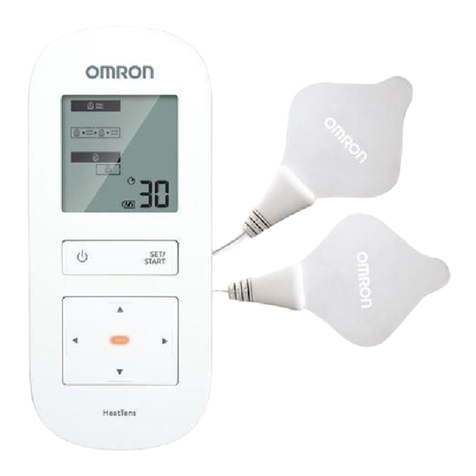
Omron
Omron HeatTens HV-F311-UK instruction manual

CU Medical Systems
CU Medical Systems i-PAD CU-SP2 Instructions for use
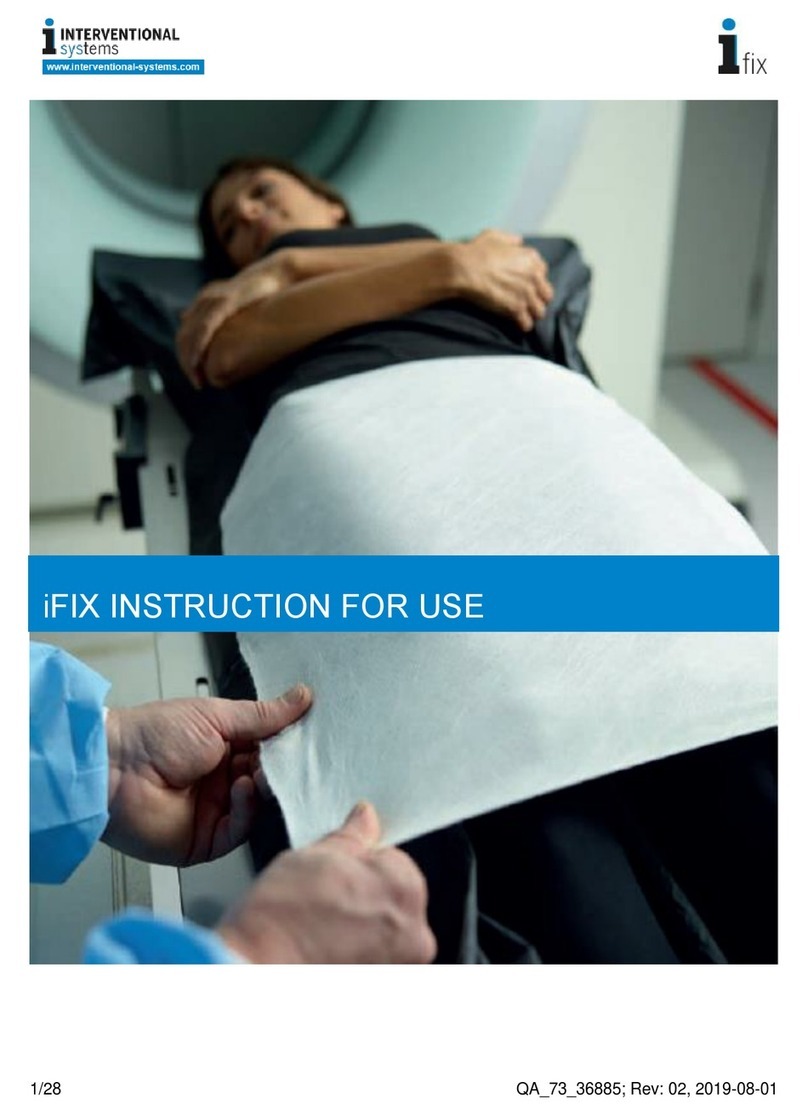
Interventional Systems
Interventional Systems iFIX Series Instructions for use
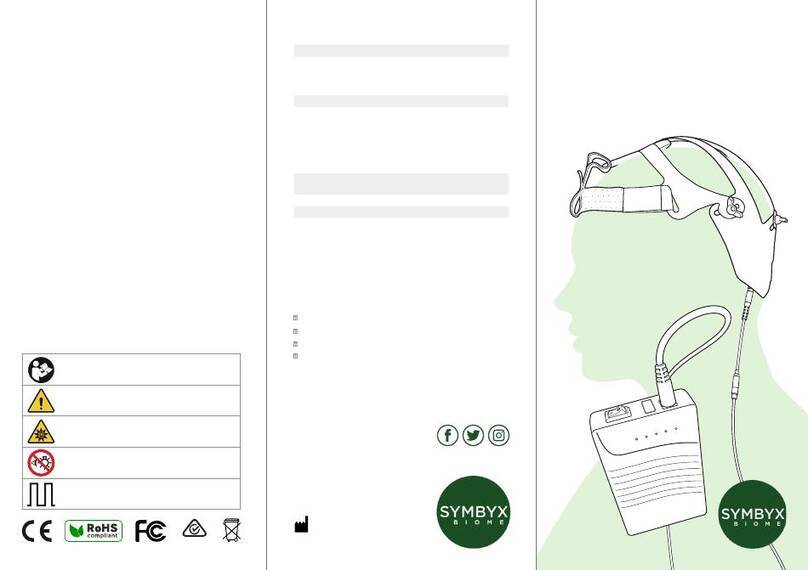
SYMBYX
SYMBYX Neuro manual
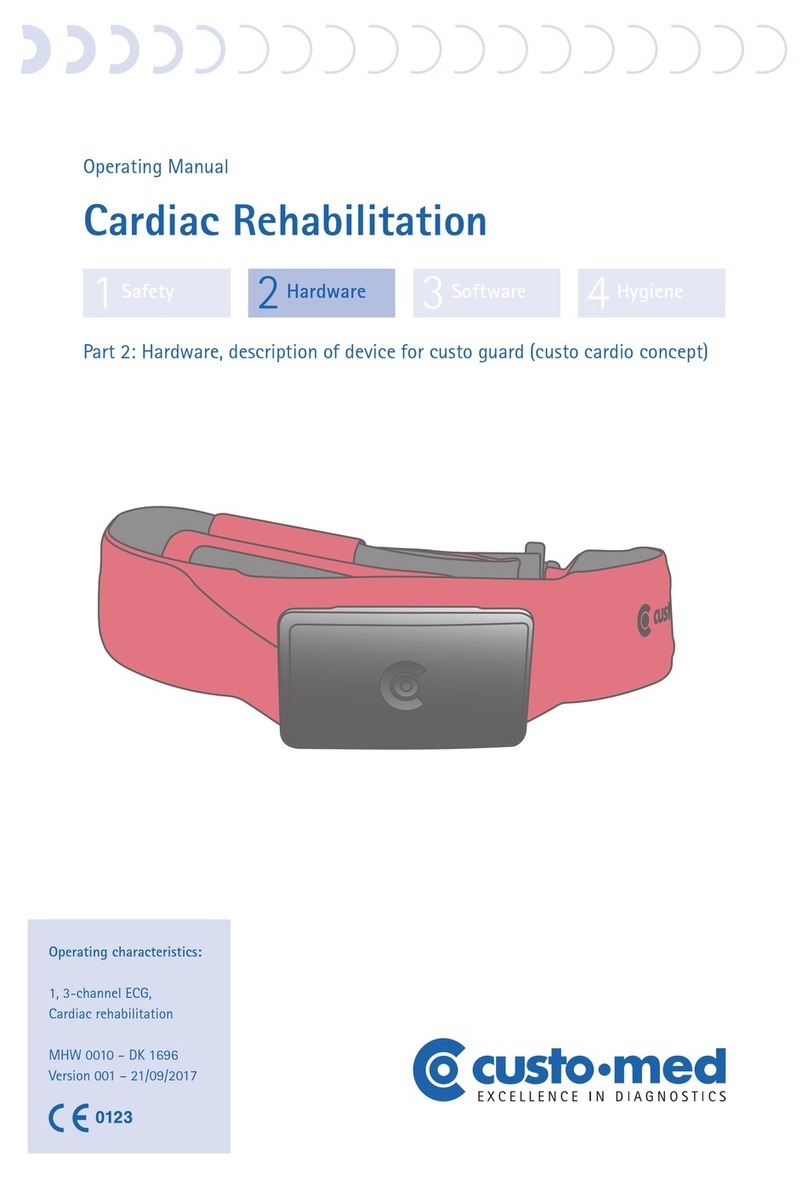
Custo Med
Custo Med Custo Guard 1/3 operating manual
